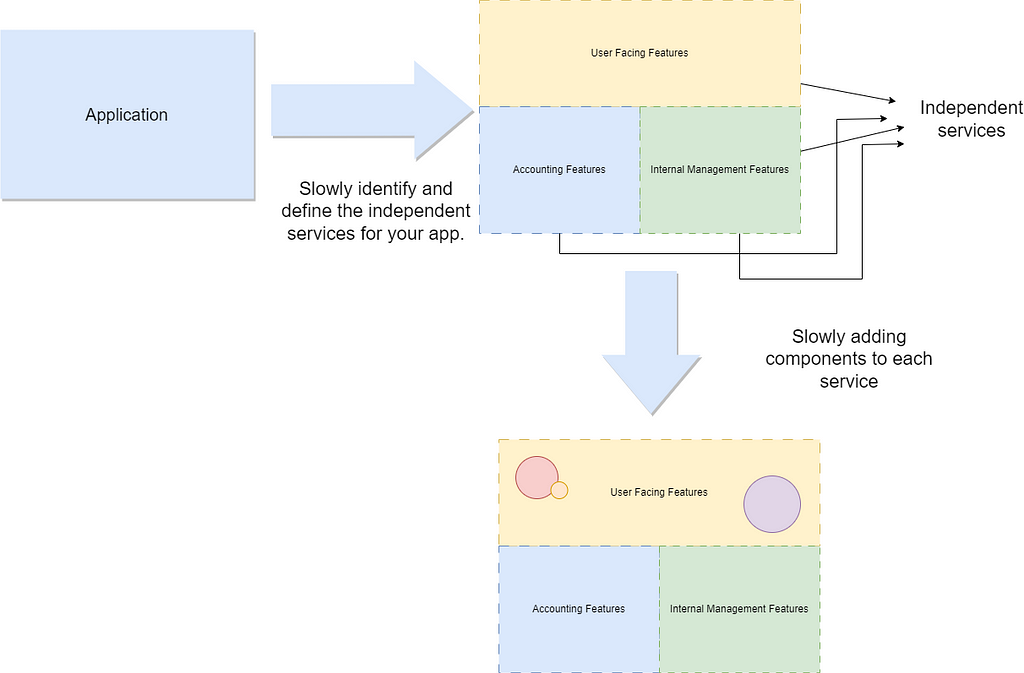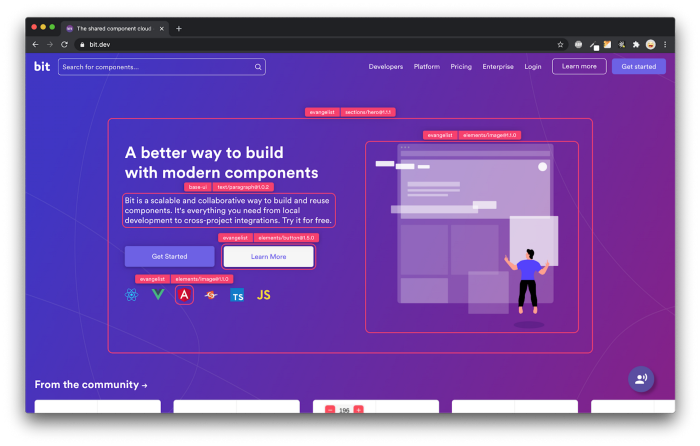This content originally appeared on Bits and Pieces - Medium and was authored by Fernando Doglio
DDD can be tough, but CDD can help solve those problems

Domain-Driven Design (DDD) is a software development approach that emphasizes understanding the business domain and modeling it in software.
However, implementing DDD can be challenging, especially for software teams that are used to working with monolithic architectures or struggle to align organizational and technical boundaries — let’s not kid each other, not every company works the same on paper and in practice.
Fortunately, Component-Driven Development (CDD) provides a solution to these challenges, and in this article, I will explain how.
Let’s first talk about the business domain
This is a concept that’s going to be mentioned several times in the article, so I want to make sure we are on the same page regarding what I mean.
So picture this: you’re running a business, and you’ve got products, services, customers, and all kinds of other stuff going on. But how do you make sense of it all? That’s where the “business domain” in DDD comes in.
Think of the business domain as the foundation of your business — it’s the essence of what you do, the unique value you provide to your customers. It’s like the special sauce in your burger or the secret ingredient in your grandma’s cookies. Without it, your business is just…meh.
So, how do you define your business domain in DDD? Well, it’s all about breaking it down into smaller, more manageable parts. You start by identifying the core concepts, like customers, orders, and products. Then you figure out what attributes and behaviors those concepts have — things like names, addresses, order statuses, and so on.
But it’s not just about what you do — it’s also about how you do it. Your business domain is all about the rules, the processes, and the workflows that make your business tick.
This is just one of many concepts related to Domain Driven Design that lend themselves well to what we have seen with the composable enterprise movement and the need to move to a composable architecture.
The Composable Enterprise: A Guide
It’s like building a virtual replica of your business — but without all the paperwork and headaches.
So there you have it — the business domain in DDD is like the heart and soul of your business. It’s the secret sauce that makes your business unique, and the foundation upon which you build your software system. With DDD, you can model your business domain in software and create a system that perfectly reflects your business.
With that said, let’s now start going through the major challenges.
Challenge #1: Understanding the Business Domain
One of the primary challenges of implementing DDD is understanding the business domain.
This requires software teams to work closely with domain experts to understand the language, concepts, and processes of the business. This is, after all, a hard requirement if you’re expecting to build any type of complex software. Once you’re outside of the “to-do app” space, you need to understand the business domain, and the better you understand it, the better app you’ll create.
However, this can be a daunting task, especially if the business domain is complex or poorly documented.
Component-Driven Development can help overcome this challenge by encouraging teams to focus on smaller, more manageable components that align with specific business needs.
By breaking down the system into smaller pieces, it becomes easier to understand the domain and build software that accurately models it. This is because each component is only related to a portion of the business domain. In other words: there is less to understand if you only focus on a subset of components.
The following diagram shows what I mean:

Furthermore, because each component is independent from each other, teams can develop autonomy and their own sense of ownership over their “neck of the woods”. Over time, that ownership will turn into expertise.
If you keep going down the component rabbit hole, you can reach a point where a subset of your developers can work on generic components that don’t really pay close attention to the Business Domain at all. And those components are later re-used by Domain teams who actually care for and know a lot about the Business Domain.
If you’re looking to get started with CDD, checking out Bit is a great way to start. You can build, test and share components easily with a very straightforward workflow. You can read this tutorial to learn more.
Challenge #2: Breaking Down Monolithic Architectures
Another challenge of implementing DDD is breaking down monolithic architectures.
Monolithic architectures are software systems where all components are tightly coupled and must be deployed together. This makes it difficult to test, deploy, and scale individual components independently, and can lead to slow, error-prone development processes. Don’t get me wrong, monoliths might sometimes have valid use cases and breaking them down is simply not worth it when that happens.

However, if you must, Component-Driven Development can help overcome the challenge of breaking up a monolith into services by encouraging teams to build small, independent components that can be easily tested, deployed, and scaled. Heck, if you go this way, you can even create reusable microservices — in the form of components — that can be combined in different ways to create multiple platforms.
Domain-Driven Modernization of Enterprises to a Composable IT Ecosystem: Part 1
The real kicker though, is that Components can also help you do that migration gradually without experiencing any lose of service. By adopting CDD you immediately gain a transition strategy out of your monolithic prison.
A while ago I wrote about how to break down a theoretical monolith with Bit, which essentially applies CDD to solving this problem. If you’re looking for a how-to guide, I recommend checking out this article.
But before we move on to the next challenge, consider the following example:
Imagine a team that is maintaining a monolithic version of a travel booking system. They’re now tasked with breaking it down to improve its performance and scalability.
Right now they have a single application that handles everything from flight booking to hotel reservations, and the team could use CDD to build smaller, independent components that handle specific tasks such as flight booking, hotel reservation, and itinerary management. They could even take it one step further and do the same on the front-end, by identifying common patterns and common UI components, they could build a different component library for the front-end, one that could be reused in future projects.
By breaking down the system into smaller, more manageable components, the team can build software that is easier to test, deploy, and scale, and that can be maintained more effectively over time. And what’s more, these components could power future projects down the line.
5 Best Tools for Domain-Driven Design
Challenge #3: Aligning Organizational and Technical Boundaries
A final challenge of implementing DDD is aligning organizational and technical boundaries. This requires software teams to work closely with business stakeholders to ensure that the software they build accurately models the business domain, while also ensuring that the software is aligned with technical constraints and organizational structures.
Component-Driven Development can help overcome this challenge by encouraging teams to build components that are aligned with business domains and can be owned and maintained by specific teams.
How to Choose Microservice’s Boundaries?
Not only that, but they can organize their work by scopes or categories according to their business responsibilities. This effectively aligns the technology with the organizational boundaries.
By breaking down the system into smaller, more manageable components, teams can assign ownership of specific components to specific teams, ensuring that each one is responsible for a specific aspect of the business domain.
In turn, this also helps ensure that the software is aligned with technical constraints and organizational structures, as each component can be developed and maintained independently.
Let’s say you’re part of a software team working for a large retail company. You’re responsible for developing the software that manages the company’s inventory — everything from tracking products as they come in from suppliers to make sure they’re properly stocked in stores.
The problem is, the company is divided into different departments, each with its own responsibilities and priorities. There’s the purchasing department, the logistics department, and the store operations department — just to name a few. And each department has its own way of doing things, its own systems and processes, and its own language and jargon.
Now, in a traditional software development environment, you might just try to force all these different departments to work together on a single monolithic system. But that’s a recipe for disaster — different teams would be stepping on each other’s toes, fighting for control over the system, and struggling to communicate effectively.
Modernizing Apps With Components
Enter DDD and component-driven development (CDD). With CDD, you can break down your monolithic system into smaller, independent components that can be owned and maintained by specific teams. This means that each department can focus on building components that are aligned with their specific business needs and processes.
The key to a successful outcome in this scenario would be proper collaboration between teams. And that is where a tool such as Bit can help. Follow this tutorial to learn how to easily collaborate with others.
So there you have it — the third challenge in DDD is all about aligning organizational and technical boundaries. By using CDD to build independent components that align with specific business domains, you can break down those boundaries and create a system that’s perfectly tailored to your organization’s unique needs.
In conclusion, Domain-Driven Design is a powerful software development approach that emphasizes understanding the business domain and modeling it in software. However, implementing DDD can be challenging, especially for teams that are used to working with monolithic architectures or struggle to align organizational and technical boundaries.
Fortunately, Component-Driven Development provides a solution to these challenges, enabling teams to build software that is more flexible, easier to maintain, and better aligned with business domains.
And tools such as Bit empower developers to work following CDD and gain all major benefits from it.
So next time you are facing challenges with implementing DDD, consider using Component-Driven Development to overcome them.

Bit’s open-source tool help 250,000+ devs to build apps with components.
Turn any UI, feature, or page into a reusable component — and share it across your applications. It’s easier to collaborate and build faster.
Split apps into components to make app development easier, and enjoy the best experience for the workflows you want:
→ Micro-Frontends
→ Design System
→ Code-Sharing and reuse
→ Monorepo
- How We Build Micro Frontends
- How we Build a Component Design System
- How to reuse React components across your projects
- 5 Ways to Build a React Monorepo
- How to Create a Composable React App with Bit
Overcoming Domain-Driven Design Implementation Challenges with Components was originally published in Bits and Pieces on Medium, where people are continuing the conversation by highlighting and responding to this story.
This content originally appeared on Bits and Pieces - Medium and was authored by Fernando Doglio
Fernando Doglio | Sciencx (2023-05-17T05:41:39+00:00) Overcoming Domain-Driven Design Implementation Challenges with Components. Retrieved from https://www.scien.cx/2023/05/17/overcoming-domain-driven-design-implementation-challenges-with-components/
Please log in to upload a file.
There are no updates yet.
Click the Upload button above to add an update.
